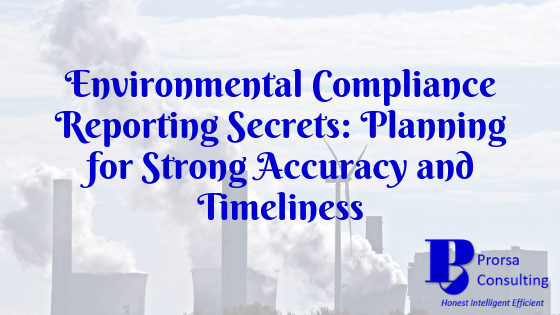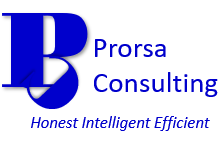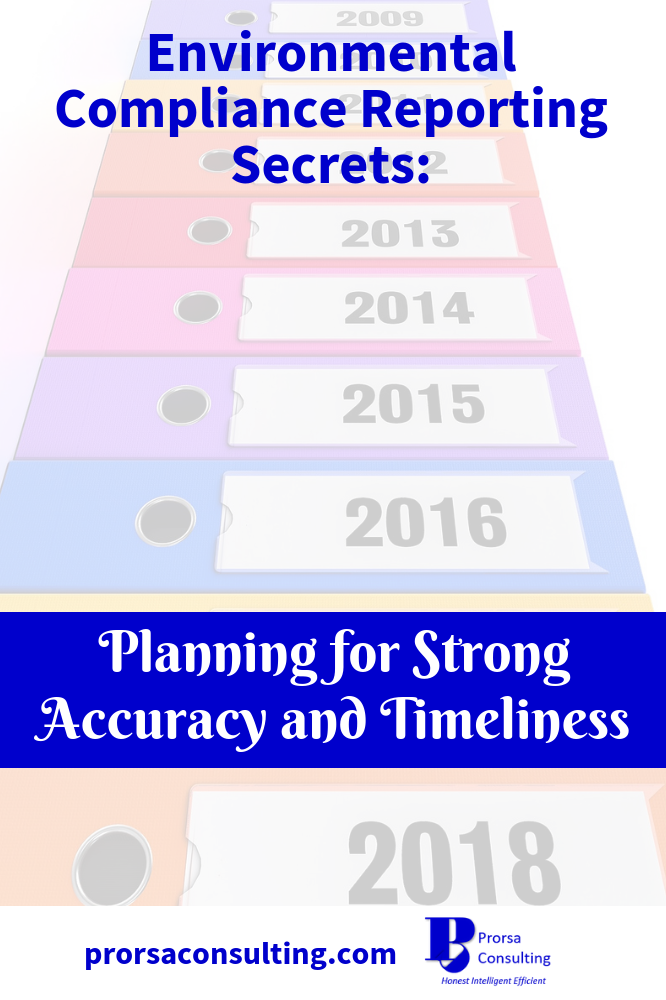Environmental Compliance Reporting Secrets: Planning for Strong Accuracy and Timeliness
By : Admin -

Happy New Year! As 2019 begins, environmental professionals start to turn their attention to all the environmental compliance reporting due during the first quarter. Depending on the complexity of the operations, the entire exercise can get overwhelming.
As with most tasks, a little planning will help to increase the chances of success. In this case, accurate reproducible, on-time reports serve as the benchmarks of success.
In addition to the strategies discussed in Completely Transform Your EHS Compliance Reporting with Simple, Robust Planning Tactics, professionals should include a few other planning secrets when preparing for annual environmental compliance reporting. So, let us explore the necessary things to get your environmental compliance reporting efforts moving in the right direction.
Disclaimer: Please be aware that this blog post may contain affiliate links and any purchases made through such links will result in a small commission for Prorsa Consulting (at no extra cost for you). Feel free to visit our Disclosure of Material Connection page for more information.
Environmental Compliance Reporting Secret 1: Utilize Official Business Data
Accurate environmental compliance reporting is important. Regulatory agencies expect your reports to be correct. Moreover, your reporting could form the basis for future permitting or other regulatory action.
As such, organizations should utilize their official business data as the basis of any calculations or estimations made for compliance reporting. Get internal agreement on your company’s official figures before beginning any reporting efforts. Also, be sure to use the same figures as you move from report to report. Furthermore, investigate any outliers within the official dataset.
Start with using official accounting numbers for items like inventory, production, fuel use, etc. When a permit requires the utilization of continuous monitoring, the figures from such monitoring take precedence.
Environmental Compliance Reporting Secret 2: Use Standardized Calculation/Estimation Methods
In staying with promoting accuracy, the methods used to calculate or estimate reporting results must be standardized. When methods differ from year to year, comparisons cannot be made over time. In such a scenario, the comparisons would be like comparing apples to oranges.
Standardized estimation methods help to protect the integrity of reporting results in the event of job changes and terminations. Thus, standardizing calculations/estimations turns these methods into repeatable processes versus a series of one-time reporting events.
Organizations should consider developing protocols for each calculation/estimation method used for environmental compliance reporting. Start with consulting relevant regulatory guidance for strategies to estimate/calculate. Moreover, use site-specific emission factors in estimations if available before generic industry factors. Finally, keep each specific calculation method the same from year to year, changing only as dictated by pertinent guidance updates or facility changes.
Environmental Compliance Reporting Secret 3: Familiarize Yourself with the Reporting Submittal Process
Part of your planning for environmental compliance reporting needs to include some preparation for the actual submittal process. Why? The agency overseeing the regulatory program may have changed since the last report.
In addition, the actual report submittal format may have been modified. Either of these events could affect the timeliness of your submittal.
Ensure you plan time to verify all items associated with completing the submittal process. Develop or procure a checklist of submittal process items to assist you. Additionally, be sure to double check your reporting due dates and publish them on your individual or shared calendar.
Furthermore, reporters need to verify their access to all environmental compliance reporting electronic platforms. Users also should review guides and/or training webinars for reporting software, as needed.
Environmental Compliance Reporting Secret 4: Review, Review, Review
Finally, organizations should send each environmental compliance report through a rigorous review process prior to submittal. Regulated entities are held to the information reported within the submittals, and the lack of a review increases the risk for inaccuracies.
Subsequently, reviews can help identify unusual results. This gives an opportunity to address questionable data before the reporting deadline. Also, reviews can signal the need to formulate justifications for any outliers that are proven accurate.
So, how should you construct a review? Official reviewers should be individuals other than the person(s) who prepared the report(s). Those persons reviewing must check for errors in any calculations/estimations and in the actual report submittal itself.
Reviewers should compare report results alongside previous years’ reporting to compare for inconsistent data. Moreover, the use of standardized calculation/estimation methods should be verified.
Other Environmental Compliance Reporting Posts for You
Responsible Official Environmental Awareness: Your Gateway to Informed Decision-making
Concluding Thoughts
Now that 2019 has arrived, the time has come to prepare for a reporting season that promotes accuracy and timeliness. By implementing the strategies in this post, you’ll have a plan to leave you with excellent environmental compliance reporting while protecting your schedule and wits.
Feel free to email contact@prorsaconsulting.com with questions concerning Prorsa Consulting’s services.
We encourage your feedback on this blog’s content. Be sure to like and/or share below. You can also give us your feedback via our Contact Us page.
Don’t forget to follow Prorsa Consulting on Google+, LinkedIn, Pinterest, and Twitter.
Get the tools you need to support your EHS program in our Free Resources area. Just subscribe below to receive access.


